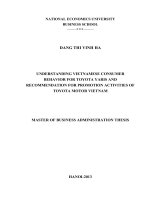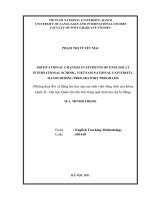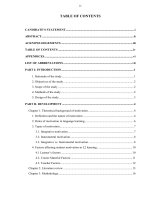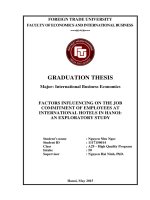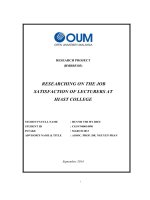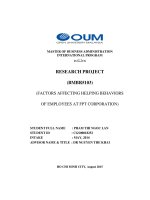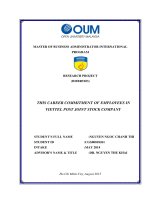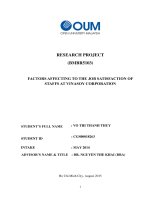Career satisfaction of employees at toyota motor vietnam
Bạn đang xem bản rút gọn của tài liệu. Xem và tải ngay bản đầy đủ của tài liệu tại đây (1.95 MB, 66 trang )
MASTER OF BUSINESS ADMINISTRATION
INTERNATIONAL PROGRAM
RESEARCH PROJECT
(BMBR5103)
CAREER SATISFACTION OF EMPLOYEES AT
TOYOTA MOTOR VIETNAM
STUDENT’S FULL NAME
: TRAN PHONG AI TU
STUDENT ID
: CGS00019375
INTAKE
: MARCH 2015
ADVISOR’S NAME & TITLE
: NGUYEN THE KHAI (DBA)
Ho Chi Minh City, July 2016
Advisor’s Assessment
----------------------------------------------------------------------------------------------------------------------------------------------------------------------------------------------------------------------------------------------------------------------------------------------------------------------------------------------------------------------------------------------------------------------------------------------------------------------------------------------------------------------------------------------------------------------------------------------------------------------------------------------------------------------------------------------------------------------------------------------------------------------------------------------------------------------------------------------------------------------------------------------------------------------------------------------------------------------------------------------------------------------------------------------------------------------------------------------------------------------------------------------------------------------------------------------------------------------------------------------------------------------------------------------------------------------------------------------------------------------------------------------------------------------------------------------------------------------------------------------------------------------------------------------------------------------------------------------------------
Advisor’s signature
TABLE OF CONTENTS
ACKNOWLEDGEMENTS ........................................................................................................ 1
ABSTRACT .................................................................................................................................. 2
1.1.
About Toyota Motor Vietnam Co., Ltd (TMV).......................................................... 3
1.1.1.
Overview TMV ....................................................................................................... 3
1.1.2.
Top manager........................................................................................................... 4
1.1.3.
Business fields ......................................................................................................... 4
1.1.4.
Products .................................................................................................................. 4
1.1.5.
History ..................................................................................................................... 4
1.1.6.
Vision and Strategy ................................................................................................ 6
1.2.
Problem statement......................................................................................................... 6
1.3.
Research objective ......................................................................................................... 7
1.4.
Scope of research ........................................................................................................... 8
1.5.
Significance of research ................................................................................................ 8
1.6.
Limitation of research ................................................................................................... 9
CHAPTER 2: LITERATURE REVIEW ................................................................................ 10
2.1.
Definition of Constructs .............................................................................................. 10
2.1.1.
Career satisfaction (CS) ...................................................................................... 10
2.1.2.
Job Conigtions (JC) ............................................................................................. 11
2.1.3.
Developmental Experiences (DE) ....................................................................... 12
2.1.4.
Career Commitment (CC) .................................................................................. 13
2.1.5.
Perceived person-organization fit (PP) .............................................................. 14
2.2.
Argument for the relationship among the constructs .............................................. 15
2.2.1.
Maslow’s theory (1943)........................................................................................ 15
2.2.2.
Alderfer’s ERG theory (1969)............................................................................. 16
2.2.3.
Previous research ................................................................................................. 18
2.3.
Research Hypotheses and Research Model .............................................................. 22
CHAPTER 3: METHODS ........................................................................................................ 24
3.1.
Data collection ............................................................................................................. 24
3.1.1.
Design Template scale.......................................................................................... 24
3.1.2.
Data collection progress ...................................................................................... 31
CHAPTER 4: ANALYSIS AND RESULTS ........................................................................... 34
4.1.
Cronbach’s Alpha ....................................................................................................... 34
4.2.
Statistics information .................................................................................................. 37
4.3.
Hypotheses testing ....................................................................................................... 39
CHAPTER 5: DISCUSSION ..................................................................................................... 45
CONCLUSION .......................................................................................................................... 47
REFERENCES ........................................................................................................................... 48
APPENDIX ................................................................................................................................. 50
Appendix 1: Survey ................................................................................................................ 50
Appendix 2: List of Figures and Tables ............................................................................... 57
Appendix 3: Presentation ...................................................................................................... 58
ACKNOWLEDGEMENTS
Firstly, I would like to express my profound gratitude and deep regards to my
advisor, Mr. Khai Nguyen DBA for his persistent and tireless help in guiding,
supporting, encouraging throughout the course of this thesis. The blessing, help and
guidance given by him time to time shall carry me a long way in the journey of life on
which I am about to embark.
In addition, I would like to thank to all the professors in the MBA course. With
their knowledgeable and intelligent comments, the current dissertation is much better
refreshed with a lot of new ideas and views.
I would like to offer thanks to Open University Malaysia and Hutech University
for granting and supporting me with the resource for this study during the time I have
studied at there. I thank all classmates have helped me during doing research as well as
during study time of MBA course.
I am obliged to board of managers and all staff members of Toyota Motor Vietnam
Co., for the valuable information and helps to collect data for this thesis. I am grateful
for their cooperation during the period of my research.
Finally, I thank almighty, my parents, brother, sisters and friends for their constant
encouragement without which this assignment would not be possible
Page 1
ABSTRACT
This study researches about the impact of the factors on positive career
satisfaction. Those factors are job cornitions (JC), developmental experiences (DE),
career commiment (CC), perceived person-organization fit (PP). We supposed that there
are significant relationships between all the above factors and positive career
satisfaction. The results based on the data collected via questionnaires from employees
of Toyota Motor Vietnam Co., Ltd (TMV) indicated that all above factors positively
impacts positive career satisfaction.
The research show that the employees who perceived their job (JC), they can
developmental experiences (DE) , the individuals commitment toward their
occupations, profession and career and the perception of his or her with an organization
more satisfaction with career success, an internally generated a defined career outcome
than employees who cognitions their job ineffective.
The findings of this study have great significance in assessing the level of career
success and employees towards their goals.
The result of this study will help leaders of TMV to improve allocation and management
of human resources effectively and stability. The satisfaction survey of staff also pointed
out defect that TMV need amend and revised methods, as well as helping the managers
make decisions related to the business. Finally, the survey will also help you build
sustainable connections with employees, retain the good employees, and attract talent.
Keywords: career satisfaction, job cornitions, developmental experiences, career
commiment , perceived person-organization fit.
Page 2
CHAPTER 1: INTRODUCTION
1.1. About Toyota Motor Vietnam Co., Ltd (TMV)
1.1.1.
Overview TMV
Toyota Motor Vietnam Co., Ltd (TMV) is an automobile Joint Ventures founded
in Semtember, 1995. The total investment capital was 89.6 million USD based on the
capital contributions from Toyota Motor Corporation (70%), Vietnam Engine and
Agricultural Machinery Corporation - VEAM (20%) and KUO Singapore Pte.Ltd
(10%).
Being one of the first automobile Joint Ventures in Vietnam, TMV never stops
making efforts to be "Moving Forward" together with Vietnam. TMV has been
incessantly providing high quality products and perfect customer services to bring the
highest satisfaction to our customers as well as positively contributing to the
development of the Vietnamese automobile industry.
Since establishment, TMV has incessantly developed not only in its sales but also
in its production scale. By now, TMV is holding the leading position in the Vietnamese
automobile market with the capacity of more than 30,000 units/year (two working shifts
a day) and the accumulated sales of TMV reaching more than 305,799 units. All our
products have a large market share in the market. With 11 employees since the first days,
the current number of employees of TMV has reached over 1,900 and more than 6,000
employees working in 41 Dealers/Dealer's Branches/TASS nationwide.
Besides the business, TMV always puts much effort into the contribution to the
state budget by fulfilling the duty of a taxpayer, as well as contributing to the sustainable
development of the community and society with various long term, practical and
meaningful activities.
Page 3
Throughout the history of establishment and development, with all our efforts from
TMV’s employees, dealers and suppliers, TMV has made great achievements and
continuously improved itself to fulfill the mission of our customers and contribute
significantly to Vietnam automobile market and society. With these achievements, TMV
has been honored with the second lever Labor Medal by the Government and seems to
be one of the most successful FDI companies in Vietnam.
1.1.2.
Top manager
-
President: Mr. Yoshihisa Maruta
-
Vice President: Madame Đoàn Thị Yến
1.1.3.
Business fields
-
Producing and assembling Toyota vehicles and Spare Parts
-
Providing the services of repairing maintaining for vehicles
-
Order and purchase from the Vietnamese supplier, including export processing
enterprises, all kinds of automobile spare parts for processing, packaging and
export.
-
Importing Toyota’s vehicles
-
Imports of automobile spare parts and equipment, specialized machinery follow
to Toyota’s standards.
-
Consulting, training, support of internal implementation of business
development, services and products maintenance to all Toyota’s affiliates,
Dealers, Candidate Dealers and TASS.
1.1.4.
-
Products
Locally-produced Toyota models: CAMRY, COROLLA ALTIS, VIOS,
INNOVA và FORTUNER
-
Imported Toyota models: LAND CRUISER, HILUX, YARIS, LAND
CRUISER PRADO, HIACE và TOYOTA 86.
-
Imported Lexus models: LS 460L, GS 350, ES 350, LX 570, RX 350, GX
460 và NX 200t.
1.1.5.
-
History
1995: Receiving the investment license for establishment.
Page 4
-
-
-
1997:
Opening of Training Center at Headquarter.
Opening of Ho Chi Minh City Brand Office.
Opening of Central Parts Depot (CPD) at Headquarter.
1998:
Opening Hanoi Branch Office.
Introducing the first generation CAMRY to meet customer demand.
1999: Becoming the first automobile manufacturer to receive ISO 14001
Certificate.
-
2000: Expanding and upgrading the Training Center at Headquarter Officially
distributing the Completely Built Up LAND CRUISER.
-
2003: Opening Stamping Shop, boosting TMV's localization rate considerably
-
2004:
Toyota Auto Parts Export Center officially put into operation.
Introducing the first ever Express Maintenance Service in Vietnam.
-
2008: Lining off the 100,000th vehicle.
-
2009: Opening Toyota South Center where transit and delivery of spare parts and
Toyota cars to Southern region.
-
2011: Lining off the 200,000th vehicle.
-
2013: Reaching a sales record with 33,288 units and an export turnover record
with 39.2 million US Dolar.
-
2014:
New record in service area with 590,000 units car put into the shop.
Introduced many new high second generation vehicles and all 5 models of
TMV are in the TOP TEN BEST SELLER CAR IN 2014.
-
2015: The 300,000th vehicle line-off.
Page 5
1.1.6.
Vision and Strategy
Toyota Vietnam will try all best to lead a good mobility and enrich lives for
Vietnamese people.
Through the commitment to quality, safety enhancement, satisfaction to
customers, contribution to Vietnam’s industry and respect for environment &
community, TMV aim to exceed expectations, to be rewarded with a smile and to be the
most beloved company in Vietnam.
TMV will meet our challenging goals by engaging the talents & passion of human
resources for a better way.
With the aim of sustainable development and "most favorite auto brand" in
Vietnam, TMV, always try our best to bring smile - the highest satisfaction - to
customers and partners, as well as positive contribution to the economy and the society.
The strategy of TMV is increasing the customer satisfaction through
diversification of products to provide more choices for customers, and also create the
value for customer by adding more benefits and improvements into new upgraded
models, such as Innova, Fortuner, Camry, Toyota 86, Hiace, Land Cruiser Prado, Yaris,
Vios and Altis. Especially, according to report of TMV about its business achievements
in 2015, it owns five models ranked top in the list of 10 best-selling cars in Viet Nam in
2015 include: Fortuner, Innova, Vios, Corolla altis and Camry (Vietnam, T. M.).
1.2.
Problem statement
The development of Vietnam's economy in recent years, the demand for manpower
is increasing as well. One of element competitions between firms is adopt policies to
attract talent. Therefore, companies have to focusing on issues rather than building
human resources, especially the selection of right people for your company. However,
choosing the right people is not enough; they must also know how to keep the best
employees and employees with experience, holding importance roles in the company.
Page 6
With the shortage of "capable" human resources as today, keeping good staff becoming
issues that business owners interest. Therefore, the only advantage is the long-term and
human resources within the organization. Each change in the business environment
conditions will increase pressure on businesses to change, actively creating new
technologies, new products, and new services to meet the growing needs of customer
goods.
Vietnam is the 150th member of the WTO, and is also a member of many other
organizations such as AFTA, APEC. Now businesses are not only competing with
domestic firms, but also to compete with foreign companies when they invest into
Vietnam. In this situation, career satisfaction is idiosyncratic assessment of each
individual in their career, and are viewed as a key indicator of the success of your career.
For this reason, I conduct this research to know clearly about some factors which
influence career satisfaction of the employees. In this study, the factors which are
evaluated to affect the employees’ career satisfaction are job cornitions, developmental
experiences, career commiment , perceived person-organization fit. The main content of
this research will show clearly how factors impact to career satisfaction. Based on
previous studies, this research give 4 factors impact to career satisfaction and that factors
and may answer the question why some people not success in career but they satisfaction
with their career.
1.3.
Research objective
The objective of this research topic to explore, analyze the factors affecting the
career satisfaction of employees working in TMV, simultaneous survey, analyze the
comments and evaluation of each employee. On that basis make comment on the
effectiveness evaluation work at the company as well as providing recommendations
and solutions to improve and enhance the operational efficiency of the management of
the Group's human resources TMV. This study focused to research and solves practical
problems about career satisfaction of employees with TMV. Subjects of the study
subjects are employee currently working for TMV.
Page 7
My research will focus 3 main factors:
-
Firstly: search related information and try to define what meaning Career
Satisfaction is of employees at TMV
-
Secondly: design research model and test related factors to check influence
between factors to access strong / weak level of each factor in influence progress.
-
Thirdly: discussing and proposing recommendation to improve the effectiveness
and forecast the human resources management at TMV in the next time.
1.4.
Scope of research
The purpose of this research is career satisfaction and factors effect to it. Consider
perceptions of employees with career and suitability of employees to the organization.
The study was conducted at two locations are HCM and Hanoi Branch Office, which
include 500 employees of TMV.
Contents of this research are only including factors influencing to Career
Satisfaction at TMV; it does not have intention of re-structuring, changing and replacing
the employees.
Implementation period is from 1-Jun to 25-Jun 2016. In this study, the I used
quantitative methods to survey and assess the career satisfaction of employees based on
5-point scale. I used a questionnaire as a tool to collect data and information of the
object. This questionnaire will be processed the data to make the results of Career
Satisfaction based on the scale was constructed. The questionnaire is listed in the
Appendix section.
1.5.
Significance of research
This research will help us understand and are more aware of the importance of
Career Satisfaction. Since then the organization can establish a plan, policy
organizations to improve career satisfaction. That is the most important significance in
connecting employees with organization. It brings stability development for
organization. For employees in career satisfaction shown satisfaction about the
psychology of individuals with their career. From there they can express themselves,
develop skills, develop loyalty to the organization.
Page 8
In addition, it also improves employee loyalty to the organization and further,
employees will be loyal to the company, contributed to the financial strength of the
companies increasingly stronger in the future.
1.6.
Limitation of research
This research will have some limitation because the limited number of employees
participating in the survey. Culture of branches in the company are different, leading to
the perception of individuals with different career.
This research only focuses related contents at TMV and also can be not generalized
for real car industry.
The survey conducted in slightly short time that I just conduct only 350
questionnaires that 280 responses were returns in which 70 questionnaires were left
blank or invalid in almost questions.
Besides, the survey respondents are more qualified and different perceptions about
Career Satisfaction as well as the contents of survey shall be more grammatical errors
because of English - Vietnamese translation progress, it may cause confusion for the
reader when they answer.
Page 9
CHAPTER 2: LITERATURE REVIEW
2.1. Definition of Constructs
2.1.1.
Career satisfaction (CS)
Career satisfaction correlated positively with having a job in general management, salary level, number of promotions received, perceptions of upward mobility,
sponsorship within an organization, acceptance, job discretion, supervisory support,
career strategies, perceived personal-organization value congruence, presence of an
internal labor market, and job performance. It correlated negatively with having reached
a career plateau (Aryee et al., 1994; Greenhaus et at., 1990; Seibert et al., 1999).
Confirmatory factor analysis showed that general perceptions of career satisfaction are
empirically distinct from financial success and hierarchical success in an organization
(Aryee et al., 1994).
Many domestic and foreign researches that companies need to create job
satisfaction for employees. Once you have the job satisfaction, the employee will be
motivated to work harder, which leads to performance and work more efficiently. This
is what business owners want out of their employees. Today, no employee satisfaction
will lead to their labor productivity is low, affecting the health both physically and
mentally. Staff job satisfaction in the workplace will be less and less change over the
holiday. The concept of job satisfaction has many different definitions from different
researchers. In this study introduces some common concepts and introduces the concept
of job satisfaction for this research.
Spector (1997) suggested that job satisfaction simply love the job and the next gas
jobs and view job satisfaction as a variable behavior. Job satisfaction is also considered
as the satisfaction with specific aspects or general satisfaction with the job. Some authors
suggest that job satisfaction is seen as influenced by the factors of the individual or labor
organization's impact on the perception of work (Bergmann, 1981 tutorial Luddy ,
2005).
Page 10
According Hoppock (1935) suggest that satisfaction with job satisfaction is a
combination of psychological, physiological and environmental factors make an
individual really feel good about their work. In other words Hoppock said that the
measure of job satisfaction is measured in two ways: (1) measuring overall job
satisfaction; (2) to measure job satisfaction in different aspects related work.
As Ellickson and Logsdon (2001) said that job satisfaction is generally defined as
the level of staff love their work, which is based on the attitude of the staff perceptions
(negative or pole) to work or their work environment. More simply, the more the work
environment to meet the needs, values and personality of the employees, the level of job
satisfaction higher.
Schemerhon (2011) defined job satisfaction as an emotional reaction and feelings
towards different aspects of the work of the staff. The author emphasizes the causes of
job satisfaction include job placement, superior supervision, relationships with
colleagues, work content, the incentives and rewards, including promotion, the physical
condition of the workplace, as well as the structure of the organization.
2.1.2.
Job Conigtions (JC)
First, discussion of participation in the trade literature often point to the fact that
employees often know (cognitively) more about how to do their jobs effectively than do
their managers. Thus including subordinates in the decision making process is viewed
as enabling leaders to make better decisions than they would make alone (Peters and
Waterman, 1982).
Second, the research on groups has often documented the benefits of group
discussion in developing effective problem solutions and action plans (Hackman and
Walton, 1986; Paulus, 1983). The present study explores the thesis that the cognitive
benefits of participation in decision making are not only important, but more important
than its motivational effects. For example, in Erez and Arad's (1986) information sharing
manipulation, the supervisors in the high condition told the subjects how to do the task
Page 11
whereas in the low condition they did not tell them how to do it. Similarly, in their high
group discussion condition supervisors answered questions about how to do the task
whereas in the low discussion condition they did not do this. Thus, these experimental
manipulations did not involve participation in decision making so much as they did task
clarification or specification. Moreover, the information flow was top down rather than
bottom up or sideways or a combination of these.
To show that participation had cognitive benefits, it would have to be shown that
the knowledge emerged from discussions by or with subordinates. In the present
experiment, task knowledge was studied as an emergent phenomenon. In addition to
showing that task relevant knowledge emerged from participation, a cognitively focused
study should ideally document what specifically was learned (e.g. what specific
strategies were developed) through participative discussions. In previous participation
studies, the task strategies were predetermined (e.g. Earley, 1985, 1986; Earley and
Kanfer, 1985) so that there was nothing the subordinates could learn except what it was
the supervisors wanted them to do.
The present study actually measured the strategies discovered used by subjects in
the participative conditions as contrasted with those in the non-participative conditions.
Thus the strategies developed during participation were treated as mediators of the
(cognitive) participation effect
2.1.3.
Developmental Experiences (DE)
This measure, developed by Wayne, Shore , and Liden (1997), describes the formal
and informaldevelopment experiences a job affords employees. It focuses on the extent
to which an organization make discretionary investment in format and informal training
and development of an employee. Work experience is central to most models of careers
and career success, as well as more general theories of work behavior and human
resource management (Ng, Eby, Sorensen, & Feldman, 2005; Quinones, Ford &
Treachout, 1995; Tesluk & Jacobs, 1998).
Page 12
The authors defined developmental job experience (DE) as an individual’s
experience of taking on demanding assignments that offer opportunity for learning and
leadership. The extent to which an assignment brings DE can depend on how the
particular employee views the opportunity in his or her own mind. Developmental
assignments usually share some common features: unfamiliar responsibilities,
opportunity to create change, high levels of responsibility, working across boundaries,
and managing diversity.
DE is associated with growth and future benefits as well as with substantial risks
and uncertainty. Depending on whether an individual perceives the assignment as a
challenge or a threat, combined with their ability to use coping skills, he or she will
experience pleasant or unpleasant feelings. These feelings lead to an overall positive or
negative outcome. The authors examined advancement potential as a positive outcome
and turnover intention as a negative outcome in the study. The authors explained that
because DE can contribute to both pleasant and unpleasant feelings at the same time,
both positive and negative outcomes can occur.
2.1.4.
Career Commitment (CC)
Career commitment is one important parts of organization commitment. Therefore,
in order to understand the concept of career commitment, we must understand the
organization commitment. Organization commitment was defined as the relative
strength of an individual’s identification with an involvement in a particular
organization (Porter and Smith, Note 4).
Career commitment can be considered one's attitude towards one's profession or
vocation, where career commitment involves the development of personal career goals
and an identification with and involvement in those goals, such that one is willing to
exert effort in support of their career, congruent with its values (Blau 1985; Goulet and
Singh 2002; Kalleberg and Berg 1987; Porter, Steers, Mowday and Boulian 1974)
Page 13
To understand the literature of career commitment is necessary to define some
terminology; career commitment had been defined as the strength of one’s motivation
to work in a chosen career role. This definition focuses on motivation and goal’s
achievement within a specific career field. The definition is based on Colarelli (1990)
and Hall (1971).
2.1.5.
Perceived person-organization fit (PP)
Consideration of person-organization fit is based on the perspective that aspects of
both an individual employee and a job situation combine to influence the individual’s
response to work (O'Reilly, Chatman, & Caldwell, 1991). That is, attitudes, behaviors,
and other individual-level outcomes result not from the person or environment
separately, but rather from the relationship between the two. The concept of fit is particularly prominent in studies of organizational stress where measures must recognize individual differences in the way situations are cognitively appraised (Edwards, 1996).
Person-organization fit refers to the degree of congruence or compatibility between
the attributes of an organization member and those of the organization. For individuals,
these attributes may include personality traits, beliefs, values, and interests. For the
organization, these characteristics traditionally include the culture, climate, values,
goals, and norms (Chan, 1996). Congruence may occur when a person supplements or
matches with other individuals in an environment, when a person’s characteristics add
something to the environment that was missing, when an organization satisfies individual needs and/or when an individual has the abilities required to meet organizational
demands (Kristof, 1996).
Value congruence is an important form of fit because organizational values are
fundamental components of organizational culture that affect employees’ attitudes and
behaviors (Chatman, 1989). Person-organization fit can be operationalized as an
individual’s goal congruence with organizational leaders and peers (Vancouver &
Schmitt, 1991). An alternative approach defines fit as the match between individual
Page 14
preferences or needs and organizational systems and structures. In general, a person will
be more satisfied with work if the environment fulfills his or her needs. Alternately,
person-organization fit can be viewed as the match between the personality
characteristics of an individual employee and organizational climate. For example, an
organization’s collectivist climate may be reflected by a team-based compensation
system that may or may not meet an individual’s need for achievement (Kristof, 1996).
There is some debate as to whether person- organization fit should be
operationalized as the compatibility of employees with specific jobs. Edwards (1991)
defined person-job fit as the agreement between the abilities of a person and the demands
of a job or the desires of a person and the attributes of a job. Although it could be argued
that jobs tend to offer a narrow view that may not be representative of an organization,
there is substantial evidence that employees may form their views about an organization
based on their experiences in their job (Hackman & Oldham, 1980). Person-organization
fit does not generally include person-vocation fit, which often reflects the similarity
between an individual’s personality and that of a vocational environment, or persongroup fit, which describes the compatibility between individuals and their work groups
(Kristof, 1996).
2.2. Argument for the relationship among the constructs
2.2.1.
Maslow’s theory (1943)
In general when we talk about the satisfaction theory is often referred to Maslow's
needs hierarchy (1943). According to his theory, human needs are divided into five
ascending levels: Physiological, Safety, Social, Esteem and Self-actualization. After a
certain demand has been satisfied, people will needs at the next higher level. From this
theory, we can see that managers need to know the level of needs of their staff where
they are to meet the next higher needs.
Page 15
Figure 1: Maslow’s hierarchy of Need Pyramid
(Source: />It is a theory of human needs, and it is considered and applied in this study because
only when the employee's needs are met, they could have satisfaction in their work.
The needs of this theory are discussed in terms of different variables. For example,
the satisfaction of Social needs can be expressed in the variables measuring Job Stress.
Similarly, the satisfaction of self-actualization needs is reflected in the svariable
Empowerment at work.
2.2.2.
Alderfer’s ERG theory (1969)
Clayton Paul Alderfer (born September 1, 1940 in Sellersville, Pennsylvania) is an
American psychologist who further developed Maslow's hierarchy of needs by
categorizing the hierarchy into his ERG theory (Existence, Relatedness and Growth).
The existence group is concerned with providing the basic material existence
requirements of humans. They include the items that Maslow considered to be
physiological and safety needs.
Page 16
The second group of needs is those of relatedness - the desire people have for
maintaining important interpersonal relationships. These social and status desires
require interaction with others if they are to be satisfied, and they align with Maslow's
social need and the external component of Maslow's esteem classification. Finally,
Alderfer isolates growth needs: an intrinsic desire for personal development. These
include the intrinsic component from Maslow's esteem category and the characteristics
included under self-actualization.
Alderfer categorized the lower order needs (Physiological and Safety) into the
Existence category. He fit Maslow's interpersonal love and esteems needs into the
Relatedness category. The Growth category contained the self-actualization and selfesteem needs. Alderfer also proposed a regression theory to go along with the ERG
theory. He said that when needs in a higher category are not met then individuals
redouble the efforts invested in a lower category need. For example if self-actualization
or self-esteem is not met then individuals will invest more effort in the relatedness
category in the hopes of achieving the higher need.
Figure 2: Alderfer’s ERG theory
(Source: www.springerplus.com/content/2/1/246/figure/F2?highres=y)
Page 17
2.2.3.
Previous research
2.2.3.1. McClelland’s theory of Human Motivation
Written by psychologist David McClelland, is a motivational model that attempts
to explain how the needs for achievement, power, and affiliation affect the actions of
people from a managerial context. This model was developed in the 1960s soon after
Maslow's hierarchy of needs in the 1940s. McClelland stated that we all have these three
types of motivation regardless of age, sex, race, or culture. The type of motivation that
each individual is driven by is changed by life experiences and the opinions of their
culture.
Figure 3: McClelland’s theory
(Source: www.mindtools.com/pages/article/human-motivation-theory.htm)
Page 18
2.2.3.2. Herzberg’s two-factor theory
Figure 4: Herzberg’s two-factor theory
(Source: www.strategicleadershipinstitute.net/news/start-with-herzberg-if-motivation-lacks-at-work/)
The two-factor theory (also known as Herzberg's motivation-hygiene theory and
dual-factor theory) states that there are certain factors in the workplace that cause job
satisfaction, while a separate set of factors cause dissatisfaction. It was developed by
psychologist Frederick Herzberg, who theorized that job satisfaction and job
dissatisfaction act independently of each other.
Two-factor theory fundamentals: Attitudes and their connection with industrial
mental health are related to Abraham Maslow's theory of motivation. His findings have
had a considerable theoretical, as well as a practical, influence on attitudes toward
administration. According to Herzberg, individuals are not content with the satisfaction
of lower-order needs at work; for example, those needs associated with minimum salary
levels or safe and pleasant working conditions. Rather, individuals look for the
gratification of higher-level psychological needs having to do with achievement,
Page 19
recognition, responsibility, advancement, and the nature of the work itself. This appears
to parallel Maslow's theory of a need hierarchy. However, Herzberg added a new
dimension to this theory by proposing a two-factor model of motivation, based on the
notion that the presence of one set of job characteristics or incentives leads to worker
satisfaction at work, while another and separate set of job characteristics leads to
dissatisfaction at work. Thus, satisfaction and dissatisfaction are not on a continuum
with one increasing as the other diminishes, but are independent phenomena. This theory
suggests that to improve job attitudes and productivity, administrators must recognize
and attend to both sets of characteristics and not assume that an increase in satisfaction
leads to decrease in un-pleasurable dissatisfaction.
2.2.3.3. Hackman and Oldham's Job Characteristics
In 1975, Greg R. Oldhamand J. Richard Hackman constructed the original version
of the Job Characteristics Theory (JCT), which is based on earlier work by Turner and
Lawrence and Hackman and Lawler. Turner and Lawrence provided a foundation of
objective characteristics of jobs in work design. Further, Hackman and Lawler indicated
the direct effect of job characteristics on employee's work related attitudes and behaviors
and, more importantly, the individual differences in need for development, which is
called Growth Need Strength in Job Characteristics Theory.
In 1980, Hackman and Oldham presented the final form of the Job Characteristics
Theory in their book Work Redesign. The main changes included the addition of two
more moderators - Knowledge and Skill and Context Satisfaction, removal of the work
outcomes of absenteeism and turnover, and increased focus on Internal Work
Motivation. Several of the outcome variables were removed or renamed as well.
Concentration was shifted to the affective outcomes following results from empirical
studies that showed weak support for the relationship between the psychological states
and behavioral outcomes.
Page 20
In addition to the theory, Oldham and Hackman also created two instruments, the
Job Diagnostic Survey (JDS) and the Job Rating Form (JRF), for assessing constructs
of the theory. The JDS directly measures jobholders' perceptions of the five core job
characteristics, their experienced psychological states, their Growth Need Strength, and
outcomes. The JRF was designed to obtain the assessments from external observers,
such as supervisors or researchers, of the core job characteristics.
Figure 5: Hackman and Oldham's Job Characteristics
(Source: edweb.sdsu.edu/people/arossett/pie/Interventions/jobdesign_1.htm)
2.2.3.4.
Previous Researches on career satisfaction
Many studies have been conducted to find out the definition, the factors that impact
on career satisfaction. As research of Greenhaus et al., 1990. They are study about
“effects of race on organizational experiences, job performance evaluations, and career
outcomes”. They found a positive relationship of individual factors such as salary, career
Page 21
